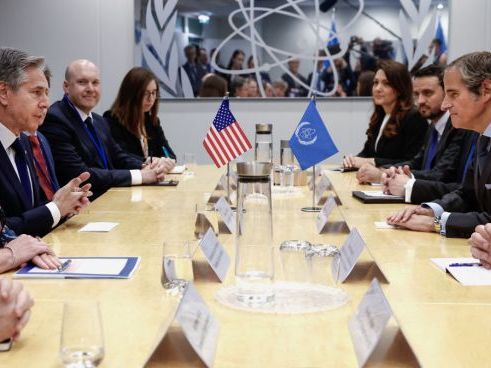Search results
Difficulties in manufacturing centrifuges
- Due to difficulties in manufacturing centrifuges, caused mainly by two sabotage events in 2020 and 2021 at its centrifuge production plants, Iran appears to be having trouble achieving the projected number of installed advanced centrifuges.
isis-online.org › isis-reports › detailUpdated Highlights of Comprehensive Survey of Iran’s Advanced ...
Mar 21, 2023 · On February 25, 2023, Iran announced to the IAEA a change in its design information for Fordow, allowing for either IR-1 or IR-6 centrifuge cascades. Thus, if Iran fails to make sufficient IR-6 centrifuges to outfit 14 cascades, it may install IR-1 cascades instead.
People also ask
Does Iran have advanced centrifuges?
Is Iran deploying advanced centrifuges in violation of JCPOA limits?
Why is Iran deploying advanced centrifuges at Natanz & Fordow?
How many IR centrifuges does Iran have?
- Key Terms and Capabilities
- The Workhorse: The IR-1
- Second-generation: The Ir-2M and IR-4
- Third Generation: The IR-6
- Fourth Generation: The Ir-8 and Ir-9
- Assessing Advances
- Production
- Implications For Weapons Production and Diplomacy
The power of each centrifuge is based on the efficiency with which it separates the different isotopes in uranium. In nature, most uranium is heavier U-238. A centrifuge separates out U-238 to increase the concentration of the much less abundant U-235, which is lighter and suitable for fission—or splitting the nucleus of an atom into two. The resul...
The IR-1, based on a design provided by Khan, is the most widely deployed centrifuge in Iran’s facilities. Research and design on the IR-1 began in earnest in the late 1990s, when Iran first successfully tested a centrifuge and made a decision to scale up its program. The output of a single IR-1 in a cascade is estimatedto be about 0.8 SWU per year...
Iran experimented with a second generation of centrifuges based on drawings and components of Pakistan’s P-2 provided by Khan. Iran subsequently modified those designs to develop the IR-2m and the IR-4. The rotor assembly of the IR-2m is made of carbon fiber and maraging steel; the IR-4’s rotor assembly is made entirely from carbon fiber. The outpu...
Iran reportedly first produced the IR-6 in 2009. In February 2013, the International Atomic Energy Agency (IAEA) confirmed that Iran was using IR-6 and IR-6s (a variant) centrifuges at the PFEP at Natanz. In 2020, Iran began testing larger cascades of the IR-6. The rotor assembly in its original design is likely made of carbon fiber; however, the I...
In December 2013, Tehran informed the IAEA of its intention to install the IR-8. It soon installed an empty casing for it at the PFEP at Natanz, possibly to include the IR-8 under the Joint Plan of Action, the precursor to the JCPOA. The IR-8’s rotor assembly is probably made of carbon fiber. Iran claims that the output of the IR-8 is between 20 SW...
Developing centrifuges with higher SWU per year is challenging. Machines that are taller and spin faster have better output, but they must be exactingly designed so as not to tear themselves apart at high rotational speeds. Each generational category used by Iranian officials to classify centrifuges thus does not necessarily represent a substantial...
Iran needs to produce advanced centrifuges in greater quantities to increase its capacity to enrich uranium. The materials necessary to operate a centrifuge cascade fall broadlyinto three categories: 1. Construction materials, such as carbon fiber, maraging steel and high-strength aluminum; 2. Items for electric power control systems, such as frequ...
The increased risk of a “sneakout” is perhaps the biggest implication of Iran’s growing mastery of centrifuge design and manufacturing. Iran could produceenough weapon-grade uranium for a single weapon in as little as four months, or enough for five weapons in 20 months, if it uses IR-2m centrifuges in one site only twice as large as the ice surfac...
Mar 17, 2022 · In the last two years, Iran has been deploying advanced centrifuges in violation of the limits in the Joint Comprehensive Plan of Action (JCPOA), following a lull of three years created by those limits. Starting in late 2020 or early 2021, it dramatically increased the number of deployed advanced centrifuges.
Sep 22, 2022 · In the last three years, Iran has been deploying advanced centrifuges in violation of the limits in the Joint Comprehensive Plan of Action (JCPOA), following a lull of three years created by those limits. Starting in late 2020 or early 2021, it dramatically increased the number of deployed advanced centrifuges.
Mar 17, 2021 · International Atomic Energy Agency Director General Rafael Grossi told member delegations on Monday that Iran has “begun feeding a newly installed cascade of 174 IR-4 centrifuges” to enrich uranium hexafluoride gas up to 5% U-235 uranium, the Vienna-based organization said.
Jun 14, 2024 · DUBAI, United Arab Emirates (AP) — Iran has started up new cascades of advanced centrifuges and plans to install others in the coming weeks after facing criticism over its nuclear program, the United Nations’ atomic watchdog said Friday. The U.S. called the moves “nuclear escalations.”
Jun 14, 2024 · DUBAI, United Arab Emirates — Iran has started up new cascades of advanced centrifuges and plans to install others in the coming weeks after facing criticism over its nuclear program, the...

